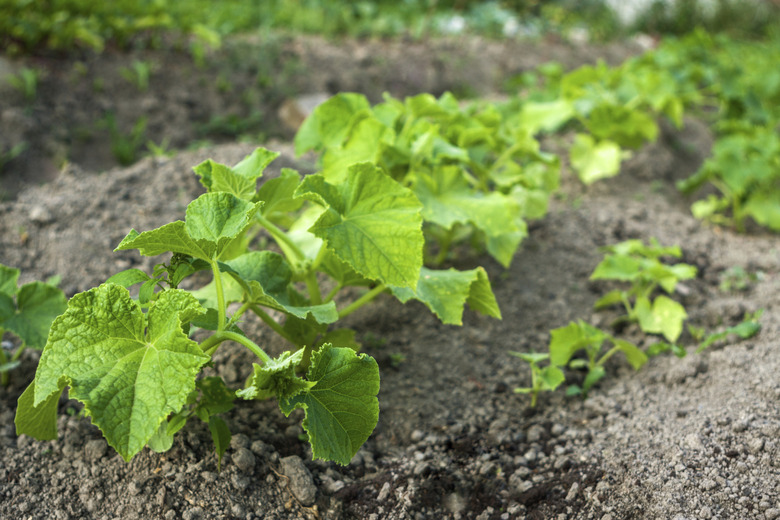How To Tell A Zucchini From A Cucumber
Zucchinis (Cucurbita pepo) and cucumbers (Cucumis sativus) are both members of the Cucurbit family, so it's no wonder people confuse these two long, slender green vegetables. While it's more obvious when you're harvesting the annual vegetables, the young plants look similar to the untrained eye. When you've planted the vines, you'll remember which is which, especially if you've labeled your garden, but volunteer summer squash and zucchini plants in unplanned spots require identification from the seedling stage.
Seedling Stage Identification
Seedling Stage Identification
Zucchini and cucumber plants look most similar in the seedling stage when there are fewer leaves and other identifying characteristics. The seed sometimes remains attached to the leaflets when the seedlings pop through the ground. Cucumber seeds are narrow, long and smooth, while zucchini seeds are short, wide, and have a small ridge around the perimeter.
The first two leaves of zucchini and cucumber seedlings are oval and virtually indistinguishable. Likewise, the second and subsequent sets of leaves are both heart-shaped with wavy edges. As the seedlings grow, cucumber seedlings tend to spread as vines, while zucchini growth is more upright.
Mature Plants Similarities
Mature Plants Similarities
The differences between zucchini and cucumber plants become more apparent as the plants mature. While leaf shape is similar, cucumber leaves are much smaller, at 4 to 5 inches in diameter, while zucchini leaves grow 12 inches in diameter or wider. Zucchini plants are often considered vines, although the growth habit of most types is more bushlike, with stems that might spread as much as 3 feet with a basically upright growth habit.
Leaves are supported by thick, hollow stalks that are covered with stiff, prickly hairs. Cucumbers may take a bush form or a vining form. The vining habit of a cucumber is much more obvious than with zucchini. The stems are similar, but cucumber stems are narrower and produce fine tendrils for climbing as they grow.
Even bush-type cucumber plants tend to spread vines along the ground, while some cucumber vines grow over 12 feet long and require a trellis. Zucchini plants produce large, trumpet-shaped, yellow or orange flowers, while yellow cucumber flowers are smaller and bell-shaped.
Fruit Exterior Comparison
Fruit Exterior Comparison
At first glance, cucumbers and zucchinis bear a striking resemblance, particularly if zucchinis are picked when small and closer in size to cucumbers. The first clue is the stem end of the fruit — zucchini has a woody stem at the end while a cucumber has a small, circular scar. Feel the two in your hand and you'll notice cucumbers have a waxy skin, while zucchini skins are dull.
Instead of perfectly smooth skin as you would find on zucchini, cucumbers are covered in tiny nubs that can even prick you before you gently rub them off with your thumbs.
Fruit Interior Comparison
Fruit Interior Comparison
Flavor is a dead giveaway for distinguishing zucchinis and cucumbers, but you can tell the difference in the interior flesh without taking a single bite. Start by cutting through the zucchini and cucumber. Immediately, you'll notice the softness of the zucchini as your knife glides through the flesh when compared to the "snap" in the crunchy cucumber.
Zucchini flesh is dry, soft and somewhat spongy — push it with your finger and it will spring back a bit. Cucumbers are moist inside, with firm flesh. The interior color is mostly white for both vegetables, but cucumbers have a slight tint of green.
